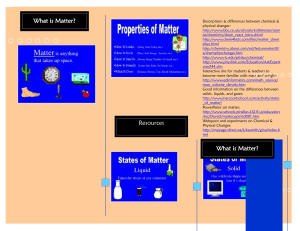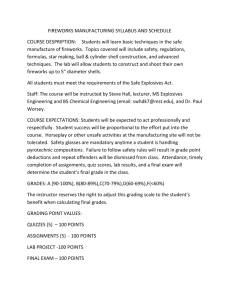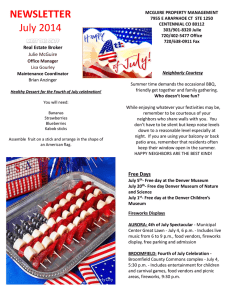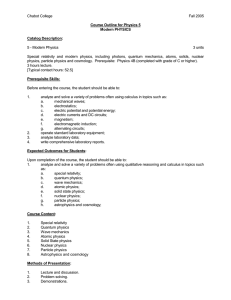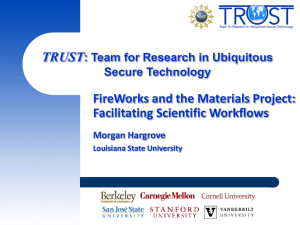Behavioral and Cognitive Evaluation of FireWorks Education Trunk Linda R. Thomas
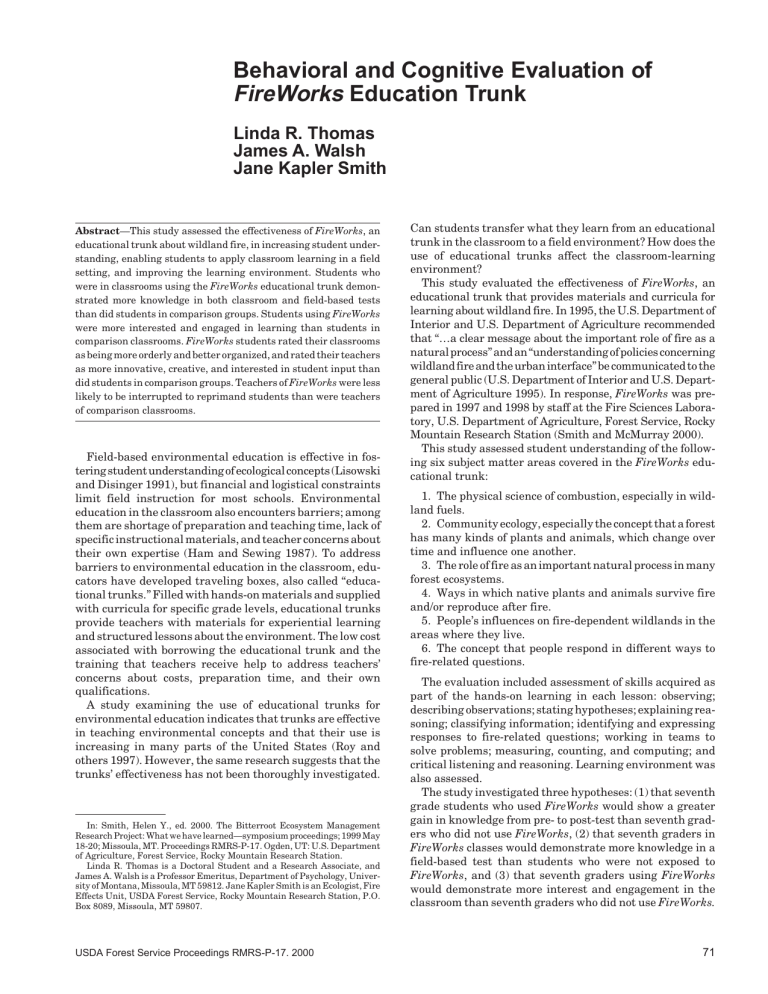
Behavioral and Cognitive Evaluation of
FireWorks Education Trunk
Linda R. Thomas
James A. Walsh
Jane Kapler Smith
Abstract —This study assessed the effectiveness of FireWorks , an educational trunk about wildland fire, in increasing student understanding, enabling students to apply classroom learning in a field setting, and improving the learning environment. Students who were in classrooms using the FireWorks educational trunk demonstrated more knowledge in both classroom and field-based tests than did students in comparison groups. Students using FireWorks were more interested and engaged in learning than students in comparison classrooms. FireWorks students rated their classrooms as being more orderly and better organized, and rated their teachers as more innovative, creative, and interested in student input than did students in comparison groups. Teachers of FireWorks were less likely to be interrupted to reprimand students than were teachers of comparison classrooms.
Field-based environmental education is effective in fostering student understanding of ecological concepts (Lisowski and Disinger 1991), but financial and logistical constraints limit field instruction for most schools. Environmental education in the classroom also encounters barriers; among them are shortage of preparation and teaching time, lack of specific instructional materials, and teacher concerns about their own expertise (Ham and Sewing 1987). To address barriers to environmental education in the classroom, educators have developed traveling boxes, also called “educational trunks.” Filled with hands-on materials and supplied with curricula for specific grade levels, educational trunks provide teachers with materials for experiential learning and structured lessons about the environment. The low cost associated with borrowing the educational trunk and the training that teachers receive help to address teachers’ concerns about costs, preparation time, and their own qualifications.
A study examining the use of educational trunks for environmental education indicates that trunks are effective in teaching environmental concepts and that their use is increasing in many parts of the United States (Roy and others 1997). However, the same research suggests that the trunks’ effectiveness has not been thoroughly investigated.
In: Smith, Helen Y., ed. 2000. The Bitterroot Ecosystem Management
Research Project: What we have learned—symposium proceedings; 1999 May
18-20; Missoula, MT. Proceedings RMRS-P-17. Ogden, UT: U.S. Department of Agriculture, Forest Service, Rocky Mountain Research Station.
Linda R. Thomas is a Doctoral Student and a Research Associate, and
James A. Walsh is a Professor Emeritus, Department of Psychology, University of Montana, Missoula, MT 59812. Jane Kapler Smith is an Ecologist, Fire
Effects Unit, USDA Forest Service, Rocky Mountain Research Station, P.O.
Box 8089, Missoula, MT 59807.
Can students transfer what they learn from an educational trunk in the classroom to a field environment? How does the use of educational trunks affect the classroom-learning environment?
This study evaluated the effectiveness of FireWorks , an educational trunk that provides materials and curricula for learning about wildland fire. In 1995, the U.S. Department of
Interior and U.S. Department of Agriculture recommended that “…a clear message about the important role of fire as a natural process” and an “understanding of policies concerning wildland fire and the urban interface” be communicated to the general public (U.S. Department of Interior and U.S. Department of Agriculture 1995). In response, FireWorks was prepared in 1997 and 1998 by staff at the Fire Sciences Laboratory, U.S. Department of Agriculture, Forest Service, Rocky
Mountain Research Station (Smith and McMurray 2000).
This study assessed student understanding of the following six subject matter areas covered in the FireWorks educational trunk:
1. The physical science of combustion, especially in wildland fuels.
2. Community ecology, especially the concept that a forest has many kinds of plants and animals, which change over time and influence one another.
3. The role of fire as an important natural process in many forest ecosystems.
4. Ways in which native plants and animals survive fire and/or reproduce after fire.
5. People’s influences on fire-dependent wildlands in the areas where they live.
6. The concept that people respond in different ways to fire-related questions.
The evaluation included assessment of skills acquired as part of the hands-on learning in each lesson: observing; describing observations; stating hypotheses; explaining reasoning; classifying information; identifying and expressing responses to fire-related questions; working in teams to solve problems; measuring, counting, and computing; and critical listening and reasoning. Learning environment was also assessed.
The study investigated three hypotheses: (1) that seventh grade students who used FireWorks would show a greater gain in knowledge from pre- to post-test than seventh graders who did not use FireWorks , (2) that seventh graders in
FireWorks classes would demonstrate more knowledge in a field-based test than students who were not exposed to
FireWorks , and (3) that seventh graders using FireWorks would demonstrate more interest and engagement in the classroom than seventh graders who did not use FireWorks.
USDA Forest Service Proceedings RMRS-P-17. 2000 71
Methods _______________________
Participants
Three school districts in western Montana volunteered to participate in the FireWorks evaluation: one an urban district, one semi urban, and one rural. Seven classrooms from three schools in the urban district participated in either the
FireWorks (n = 5) or the nonFireWorks comparison groups
(n = 2). Both the rural school district and the semi urban district each had one school with three classrooms that received the FireWorks curriculum (n = 6). No comparison groups came from either the rural or semi-urban district. A total of 313 seventh grade students participated in the study
(treatment group n = 261; comparison group n = 52).
Assessment Procedures
Two approaches were used to evaluate the effectiveness of FireWorks in increasing student understanding: cognitively oriented pre- and post-tests, and a behavioral assessment in a field setting. Students’ perceptions about the classroom environment were surveyed. Teachers, students, and the interactions between them in the classroom were also observed.
Pre- and Post-Test Cognitive Measure —Two 13-item, multiple-choice tests were constructed from sample questions submitted by each of the volunteer teachers who would be teaching the FireWorks curriculum. The two forms of the test (A and B) addressed the same learning domain. All participating classrooms used Form A as the pretest and
Form B as the post-test.
Field Test —Field tests were conducted at six “information stations.” Each station was staffed by a “stationmaster” who gave each student a single task to perform, evaluated the student’s answer, and punched the student’s response card to indicate whether the answer was correct or not.
Tasks for the field test were based on the lessons in the
FireWorks curriculum.
Classroom Environment Scale (CES) —Students in all FireWorks and comparison classes completed the CES, a
90-question survey with true or false response choices that make up nine subscales. The CES purports to measure conditions in which students can learn (Felner, Ginter, and
Primavera 1982, as cited in Moos and Trickett 1995). It also systematically assesses relationships among students.
Classroom Observations —Time sampling was conducted during FireWorks instruction in treatment classrooms and during the same time period in comparison classrooms.
Results ________________________
Students using FireWorks demonstrated a significant gain in knowledge about wildland fire from pre- to post-test, significantly different from the change in knowledge by comparison students [F (1,1) = 14.54, p < .0005] even though many had studied fire ecology the previous year. Students using FireWorks performed significantly better in a field demonstration of skills than did students who did not receive the FireWorks instruction [F (1, 239) = 13.65, p < 0.0005].
FireWorks students perceived their classrooms as more positive places for learning than did students in comparison classes. According to the Classroom Environmental
Scale, FireWorks students perceived themselves as more attentive and interested in class activities than did comparison students [F (4,211) = 14.95, p < 0.0005]. Students viewed FireWorks teachers as more trusting and interested in student ideas [F (4,211) = 10.76, p < 0.0005], more likely to emphasize completion of activities [F (4,211) =
4.32, p = 0.002], more innovative and more likely to encourage creative thinking than teachers not using Fire-
Works [F (12,278) = 11.58, p < 0.0005]. Students in
FireWorks classrooms were more likely than students in comparison groups to report competition with other students for grades and teacher recognition [F (4,211) = 4.10, p = 0.003]. FireWorks students rated their classrooms as being more orderly and organized than did students in comparison groups [F (4,211) = 10.38, p = 0.0005].
Classroom observations indicated that teachers in
FireWorks classrooms were significantly less likely to interrupt instruction in order to reprimand students for infractions of rules than were teachers of comparison classrooms
[F (1, 14) = 4.96, p = 0.043].
Discussion _____________________
This study demonstrated that FireWorks , a curriculum about wildland fire available as a traveling educational trunk, was effective in increasing understanding of wildland fire behavior and fire ecology by seventh grade students.
Educators often seek to teach about ecology and outdoor skills in their classrooms, either to maximize the value of a subsequent field trip or to take the place of field trips, which may be expensive or difficult to schedule. This study suggests that educational trunks can be effective for teaching field related knowledge and skills in the classroom. After using FireWorks , the seventh graders in this study were able to discuss fire behavior and fire ecology in the field; they assessed potential fire spread, identified tree species, and critiqued the safety of homes in forested areas.
Classroom observations and student responses to the
Classroom Environment Scale indicated that a structured, hands-on learning program such as FireWorks can facilitate a better learning environment, more positive perceptions of the teacher, and greater student involvement than does routine instruction. The positive influences of a trunk-based educational program on understanding and the learning environment are probably not limited to seventh graders.
Research assessing the influence of structured, hands-on learning on perceptions of adult learners would be helpful for educators and agency staff who plan and implement educational programs about ecology.
The FireWorks educational trunk addresses several of the barriers to environmental education reported by Ham and
Sewing (1987): FireWorks minimizes teacher preparation time by providing background, lesson plans, and student handouts ready to use. It eliminates costly expenditures by providing all specialized supplies and equipment for experiments. It provides specific instructional materials and sample
72 USDA Forest Service Proceedings RMRS-P-17. 2000
exams. Finally, it provides resources for increased teacher competence in education about wildland fire.
Even though students using FireWorks showed evidence of increased knowledge about fire ecology, this study did not investigate whether they actually used any of this information. Research is currently underway to determine how much knowledge gained from FireWorks was retained for one year. Informal assessment is being conducted to determine whether knowledge gains resulting from use of
FireWorks influence a student’s future behavior regarding wildland fire. This information and formal assessment of long term effects on student attitudes and behavior would be useful to those who examine the cost-effectiveness of educational programs.
References _____________________
Ham, S. H.; Sewing, D. R. 1987. Barriers to environmental education. Journal of Environmental Education. 19(2): 17-24.
Lisowski, M.; Disinger, J. F. 1991. The effect of field-based instruction on student understandings of ecological concepts. Journal of
Environmental Education. 24(1): 19-23.
Moos, R.; Trickett, E. 1995. Classroom Environment Scale: Development, Applications and Research, Third Edition. Palo Alto, CA:
Consulting Psychologists Press, Inc.
Roy, M.; Petty, R.; Durgin, R. 1997. Traveling boxes: A new tool for environmental education. Journal of Environmental Education .
28(4): 9-17.
Smith, Jane Kapler; McMurray, Nancy E. 2000. FireWorks Educational Trunk. In: Smith, H. Y., ed. The Bitterroot Ecosystem
Management Research Project: What we have learned: Symposium proceedings; 1999 May 18-20; Missoula, MT. Proc. Ogden,
UT: U.S. Department of Agriculture, Forest Service, Rocky Mountain Research Station.
U.S. Department of Interior and U.S. Department of Agriculture.
1995. Federal wildland fire management policy and program review, final report (December 18, 1995). Boise, ID: National
Interagency Fire Center, Bureau of Land Management, Office of
Fire and Aviation. 45 p.
USDA Forest Service Proceedings RMRS-P-17. 2000 73
